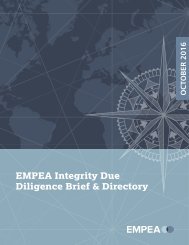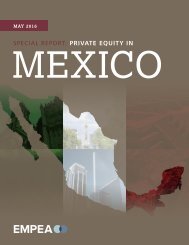Create successful ePaper yourself
Turn your PDF publications into a flip-book with our unique Google optimized e-Paper software.
investor market. Examples <strong>of</strong> studies include the African<br />
Development Bank’s “Structured Finance: Conditions for<br />
Infrastructure Project Bonds in African Markets.”<br />
There is evidence to suggest that financial centres go hand<br />
in hand with economic development. But what this means<br />
for donors in terms <strong>of</strong> shaping their policies and interactions<br />
in African countries needs more analysis. As a starting<br />
point, it is important to acknowledge the difference between<br />
regional centres and administrative centres in terms <strong>of</strong> the<br />
developmental benefits each model brings and the policies<br />
needed to catalyse the growth <strong>of</strong> either type <strong>of</strong> centre. This<br />
may also inform the debate between ‘onshore centres’<br />
and ‘<strong>of</strong>fshore centres’ since, as we have acknowledged<br />
elsewhere, most <strong>of</strong>fshore centres are administrative centres.<br />
Does it really make sense for donors to promote the creation<br />
<strong>of</strong> more than one administrative (<strong>of</strong>fshore) centre for Africa<br />
when it seems that most fund managers find that Mauritius<br />
is serving these needs well?<br />
If transparency is the main concern, there is an argument<br />
to focus efforts on that issue specifically and to work with<br />
policymakers and financial institutions in Mauritius to<br />
improve those standards. Indeed, there may even be an<br />
argument for donors to help Mauritius improve its current<br />
capabilities such that it is seen as a world class administrative<br />
centre. It will be able to achieve the benefits <strong>of</strong> economies <strong>of</strong><br />
scale and may in due course attract international providers<br />
<strong>of</strong> these services.<br />
benefits <strong>of</strong> investing in infrastructure, and the benefits <strong>of</strong><br />
commercial markets in key sectors <strong>of</strong> the economy. At the<br />
same time, building a regional financial centre would create<br />
a centre with greater capacities than a typical national<br />
centre. This may then attract financial activity to this centre<br />
at the expense <strong>of</strong> its surrounding national centres.<br />
So, for the debate over creating bigger regional centres the<br />
key questions are:<br />
−<br />
−<br />
−<br />
−<br />
−<br />
How many regional centres can the African continent<br />
accommodate?<br />
Which national centres have the ability to grow and<br />
service neighbouring countries?<br />
What would be the effect on the region and the<br />
immediate proximity <strong>of</strong> the regional centre?<br />
Do the relevant national centres have policymakers<br />
alive to this potential and willing to undertake the<br />
necessary policy measures?<br />
What policy measures are necessary to catalyse the<br />
growth <strong>of</strong> such centres?<br />
For donors, the important questions revolve around<br />
understanding the advantages and possible disadvantages<br />
<strong>of</strong> creating larger regional centres. This does not need to be<br />
a purely theoretical exercise; there are obvious precedents.<br />
These show that global, regional and national centres<br />
coexist. However, once a regional centre has established<br />
itself, it is resilient and not easily dethroned by other national<br />
centres achieving the regional centre status.<br />
Indeed, donors need to acknowledge that in the cases <strong>of</strong><br />
countries such as Mauritius or the Cayman Islands, the<br />
creation <strong>of</strong> administrative centres was the result <strong>of</strong> proactive<br />
government policies to create development in those small<br />
economies. Those economies are not large enough or have<br />
enough other alternatives to be able to diversify if these<br />
activities moved elsewhere.<br />
In the absence <strong>of</strong> a regional (onshore) centre in Africa, it<br />
is expected that as any African country develops, its main<br />
commercial centre will develop as a national financial<br />
centre.<br />
For example, in the Middle East, Dubai occupies a role<br />
as the dominant regional financial centre. It is certainly<br />
the dominant financial hub, it has the largest regional<br />
stock market and it has the largest collection <strong>of</strong> financial<br />
services companies in the region. However, Doha, Bahrain<br />
and Abu Dhabi all have their own financial markets that<br />
coexist with Dubai. At the same time, Dubai coexists with<br />
the global centres. In fact, companies in Doha may need to<br />
work through Dubai for some specialised services and for<br />
other services—capital raising in particular—they will turn<br />
to London, New York or Hong Kong. So the role <strong>of</strong> Dubai<br />
varies according to the needs <strong>of</strong> the client.<br />
We can even argue that this is important in order for the<br />
national economy to continue to grow and to benefit from<br />
best practice in financial markets and financial products.<br />
Donors should be looking to help at this national level by<br />
advocating the benefits <strong>of</strong> improving financial markets, the<br />
Similarly, the development <strong>of</strong> Central Europe since 1989<br />
went hand in hand with the development <strong>of</strong> their national<br />
financial centres in countries such as Poland, Slovakia<br />
and the Czech Republic. Yet, there has not been the<br />
creation <strong>of</strong> a single centre to service the region. They<br />
112 |





